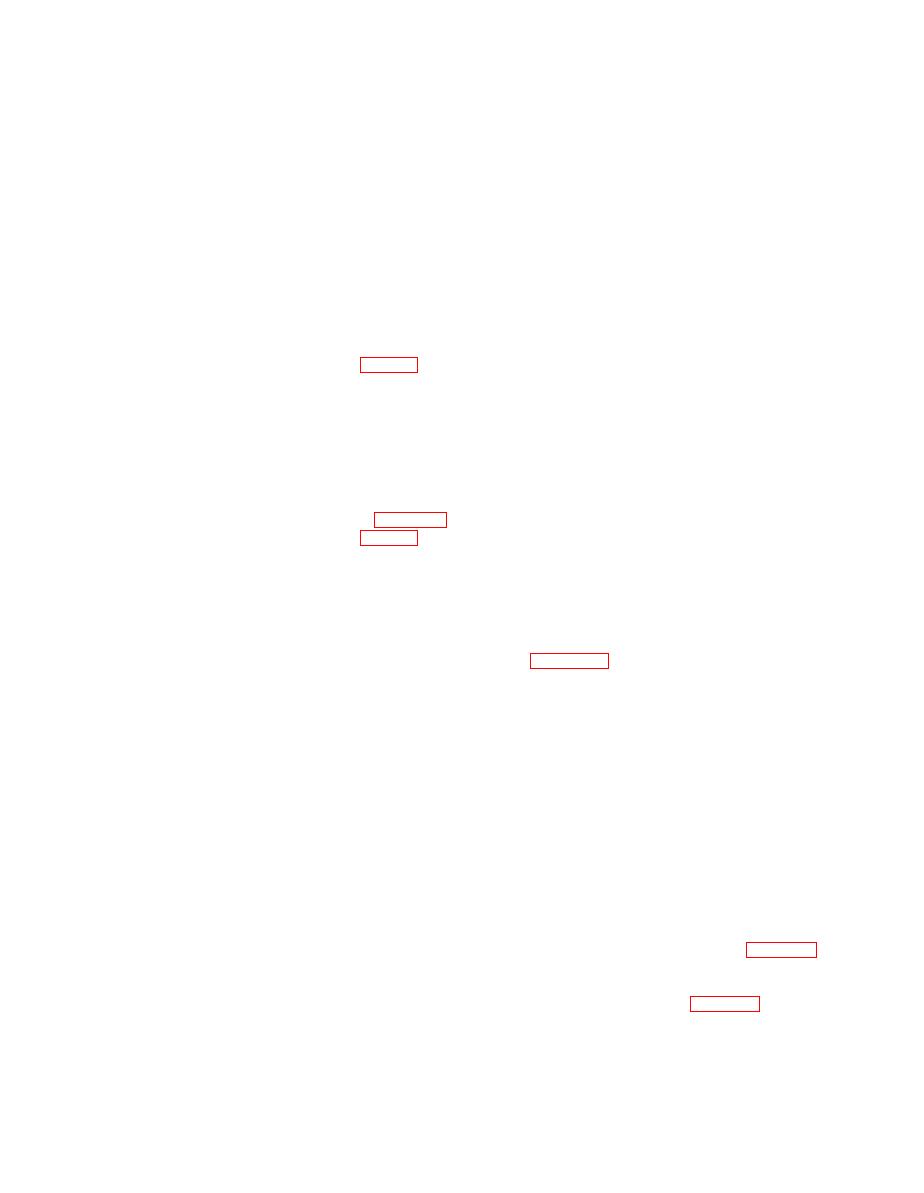
TM 5-4930-218-14
do not spin the bearings. After cleaning, dip bearings
(3) Release all air from the inner tube and remove
into a container of clean engine oil and wrap them in
the tire (2) tube (3) from the wheel (4).
lint-free paper to prevent contamination by dust or
b. Cleaning and Inspection.
(1) Clean the tire, tube, and wheel with a
dirt.
(2) Discard and replace the grease seal (19) each
pressurized stream of water. Wipe any greasy or
gummy deposits from the wheel with a cloth dam-
time the hub and drum are disassembled.
(3) Clean all remaining parts with solvent and
pened with dry cleaning solvent (fed. spec. P-D-680).
(2) Inspect the tire for cracks, punctures, im-
dry thoroughly.
(4) Inspect the bearing cones for cracks, scored or
bedded foreign materials, cuts, and tears. Remove
foreign materials and skive around cuts to prevent
rough rollers or races, binding or catching operation,
or signs of overheating. Replace damaged bearing
them from tearing farther into the sound rubber of
the tire.
cones.
(3) Inspect the tube for deterioration, cracks,
NOTE
If either the bearing cones or cups are damaged, you
cuts, and leaks. If necessary, partially inflate the
must replace both parts as a matched set. Do not at-
tube and immerse it into a container of water to
tempt to use new cups with old cones or vice versa.
check for leaks. Patch any leaks.
(5) Inspect the bearing cups in the hub for scoring,
roughness, or other damage; if defective, press them
(2) on the wheel (4) and inflate to 50 psi. Check that
out or drive them out using a hammer and soft drift,
the tire retains its pressure. Secure the assembled
(6) Inspect the brake drum for cracks, wear,
tire and wheel to the lubricating and servicing
roughness, out-of -roundness, scoring, or other
assembly with six nuts (1). Lower the jack so that the
damage. Turn and grind the inside diameter of the
unit rests on the ground.
drums if defective.
(7) Check all shoulder bolts for looseness, cracks,
4-58. Wheel Hub and Drum.
and damaged threads. If damaged, drive out the bolts
a. Removal and Disassembly.
and drive in new ones. If the hole in the hub or drum
(1) Remove the wheel and tire (para 4-57a).
adapter is enlarged so that tight bolt mounting is not
(2) Remove the three screws (5, fig. 4-19) and lock
possible, replace the hub or adapter.
washers (6) that secure the hub cap (7) to the wheel
(8) Inspect all other parts for cracks, distortion,
hub; remove hub cap and gasket (8).
damaged threads, and other damage; replace
(3) Bend up the tang of nut lock (10) and remove
damaged parts.
nut (9) and nut lock. Remove the bearing retaining
c. Reassembly and Installation.
nut (11).
(1) Reassemble and install the hub and drum in
(4) Remove six nuts (13) and remove the assem-
the reverse order of disassembly and removal. Refer
bled hub with bearings from the axle. Remove the
to figure 4-19.
outer and inner bearing cones (12 and 18) from the
(2) If bearing cups (15 and 16) were removed from
hub (17). Do not remove the bearing cups (15 and 16)
the hubs (17), press in new bearing cups squarely un-
from the hub unless inspection indicates that they
til they are fully seated in the hubs.
are damaged and must be replaced.
(3) During reassembly, pack the wheel bearings
(5) Remove the grease seal (19) and grease seal
with grease, following recommendations given in
sleeve (20) from the axle.
L.O. 5-4930-218-12.
(6) Disassembly of the brake drum (23) from the
(4) To provide proper bearing adjustment,
adapter (26) is not necessary unless either part is
tighten the nut (11) while rotating the wheel. Con-
damaged and requires replacement.
tinue to tighten until a distinct drag on the wheel is
felt, then back off the nut just enough to remove the
b. Cleaning and Inspection.
drag. Install the nut lock (10) and outer nut (9),
(1) If the bearings are in good condition and can
taking care not to upset the adjustment as the second
be reused, place them in a wire basket and flush them
nut is installed. Bend down one tang of the nut lock
up and down in a container of dry cleaning solvent
against a flat of the outer nut to lock the adjustment,
(fed. spec. P-D-680) to remove all caked and hardened
(5) Use a new hub cap gasket (8) when installing
grease. If necessary, rap the end sharply against a
the hub cap (7).
soft-wood block to dislodge the grease, Air-dry the
(6) Install the wheel and tire (para 4-57c).
bearings. If compressed air is used, take care that you
Section XVIII. TRAILER BRAKE SYSTEM
hydraulic system. Refer to figure 1-6. A dual system
4-59. Description
is used so that braking action will still occur even
a. The trailer brakes are operated by an air-over-


